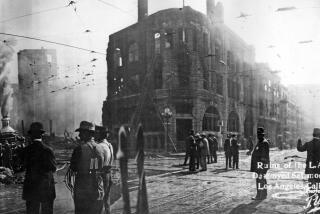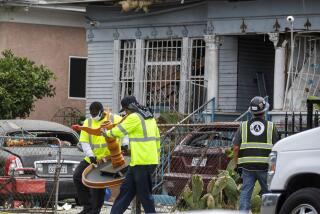Taggants: Still a better way to track a bomber
- Share via
A number of commenters on the online version of our April 28 Op-Ed, “A better way to track a bomber,” argue against the use of taggants to trace explosives because the suspects in the Boston bombings, the Tsarnaev brothers, were identified through other means -- namely the publicizing of videotape from the scene and the flood of resulting tips. That’s certainly true. However, taggants at the scene might have brought about a quicker and cleaner investigation, and perhaps avoided the death of one law enforcement officer and a city held hostage.
After the videotape was broadcast internationally, the Tsarnaev brothers appear to have armed themselves and prepared, erratically, to escape Boston or to precipitate a last stand or to bomb again. That might not have been the case with a quieter taggant investigation.
Sean S, among the commenters, also says that because the Boston bombs contained fireworks propellant, they wouldn’t have been covered by the taggants legislation that the National Rifle Assn. helped to squelch. But that is not the case. The gunpowder used in fireworks -- a secondary use of the product -- would still have had to contain taggants placed there by the gunpowder manufacturer.
And as the Op-Ed pointed out, that could have quickly yielded an important clue that would have led the FBI within hours to the Phantom Fireworks stand in Seabrook, N.H., where, as the proprietor told reporters, he remembered the odd Tsarnaev purchase. As it was, Phantom ran the name through its database three days after the bombings, after the suspects had been identified publicly, and then called the FBI.
Our Op-Ed did not hold out taggants as a magic solution. Think of them as little specks of artificial DNA at the scene that point not to an individual but to a possible place where the bomb materials were purchased. If you were a police detective, you’d really like to have that information. And if you’re the victim of a bombing, or a family member, you’re definitely going to want the police to have that information.
ALSO:
New sheriff in town? Not often in L.A. County
Kenny Smith schools Chris Broussard on inclusiveness
After Boston memorial, nonbelievers complain about being left out
Tom Zoellner, an associate professor of English at Chapman University, is the author of “A Safeway in Arizona: What the Gabrielle Giffords Shooting Tells Us About the Grand Canyon State and Life in America.” Sam Kleiner is a student at Yale Law School.
More to Read
A cure for the common opinion
Get thought-provoking perspectives with our weekly newsletter.
You may occasionally receive promotional content from the Los Angeles Times.









